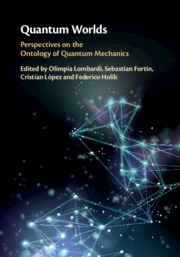Book contents
- Quantum Worlds
- Quantum Worlds
- Copyright page
- Contents
- Contributors
- Preface
- Introduction
- Part I Ontology from Different Interpretations of Quantum Mechanics
- 1 Ontology for Relativistic Collapse Theories
- 2 The Modal-Hamiltonian Interpretation: Measurement, Invariance, and Ontology
- 3 Quantum Mechanics and Perspectivalism
- 4 Quantum Physics Grounded on Bohmian Mechanics
- 5 Ontology of the Wave Function and the Many-Worlds Interpretation
- 6 Generalized Contexts for Quantum Histories
- Part II Realism, Wave Function, and Primitive Ontology
- Part III Individuality, Distinguishability, and Locality
- Part IV Symmetries and Structure in Quantum Mechanics
- Part V The Relationship between the Quantum Ontology and the Classical World
- Index
- References
3 - Quantum Mechanics and Perspectivalism
from Part I - Ontology from Different Interpretations of Quantum Mechanics
Published online by Cambridge University Press: 06 April 2019
- Quantum Worlds
- Quantum Worlds
- Copyright page
- Contents
- Contributors
- Preface
- Introduction
- Part I Ontology from Different Interpretations of Quantum Mechanics
- 1 Ontology for Relativistic Collapse Theories
- 2 The Modal-Hamiltonian Interpretation: Measurement, Invariance, and Ontology
- 3 Quantum Mechanics and Perspectivalism
- 4 Quantum Physics Grounded on Bohmian Mechanics
- 5 Ontology of the Wave Function and the Many-Worlds Interpretation
- 6 Generalized Contexts for Quantum Histories
- Part II Realism, Wave Function, and Primitive Ontology
- Part III Individuality, Distinguishability, and Locality
- Part IV Symmetries and Structure in Quantum Mechanics
- Part V The Relationship between the Quantum Ontology and the Classical World
- Index
- References
- Type
- Chapter
- Information
- Quantum WorldsPerspectives on the Ontology of Quantum Mechanics, pp. 51 - 70Publisher: Cambridge University PressPrint publication year: 2019
References
- 11
- Cited by



